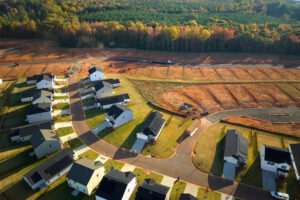
As we start a very cold year, at least on the East Coast, I look back on 2017 and think about what it might mean with regards to 2018 housing market. Last year I said that, although I was part of the glass half-full crowd, I had no idea how to predict where we might end up in 2017. I talked about uncertainty and the fact that it was so much more difficult to look at the statistics and make any credible conclusions as to what they meant. I was speaking primarily about the uncertainty in the housing market. But boy, I’m not sure I could have predicted all that has gone on in 2017 outside of housing. We live in a world of continuous “noise” and it’s difficult to cut through all of that noise to understand what is really happening. Extreme partisanship, fake news, geopolitical risks, foreign interference, “me too”, ISIS, hurricanes, and the list goes on. Makes you want to hole up in your home and stay there. But to do that, you need a home.
We ended up with a solid year in the housing market. New home sales are up about 8% from 2017 with existing home sales up a little over 1%. We had 608,000 new home sales and 5.51 million of existing home sales for 2017. Housing starts were slightly less than 1.2 million. Interest rates are higher but still at historical lows, just below 4%. Inflation remains in check and GDP had an uptick the last half of the year. Job growth was strong but less than the prior year’s. The stock market rose to record highs. The end of the year saw continued improvement in builder confidence and consumer sentiment. Should we feel good about the prospects for housing in the coming year considering the positive signs we are seeing? The answer is, I believe, yes. But is housing poised to be the hare in 2018? Unfortunately, I still see headwinds.
We continue to have affordability issues that need to be addressed. Housing prices once again increased by 5%-6% in 2017 and the median home price for a new home topped $330,000 with the average price over $399,000. Credit remains too tight and wage growth has been slow. Overall inventory levels remain extremely low. From a builder perspective, land costs remain high along with labor and materials. Higher land costs will challenge margins unless you can build a higher priced home. Skilled labor is difficult to find and increased demand will result in increased costs. With the ongoing disputes between the US and Canada on soft lumber imports, and with other increases in building materials, the overall cost of building will continue to rise. All of these factors shrink margins for builders and provide them little incentive to construct entry priced homes and, therefore, limiting choices for new buyers.
Another unknown is the effect the new tax bill will have on the housing market. There has been a significant gnashing of teeth by some in the industry that this will hurt the market by substantially reducing home prices and taking millions of potential home buyers out of the market due to the reduction in the mortgage interest deduction and the capping of state, local and property tax deductions. But it seems to me that the effect, if any, will only be at the upper end of the market and with the higher taxed states. Limiting the mortgage interest deduction to homes of $750,000 or less should not significantly affect your average home buyer and, although there may be an effect in high tax states, capping the deduction on state, local and property taxes should probably have a limited effect on most Americans. Although certainly a consideration in the decision process, I’ve always believed that the primary reason for purchasing a home was not to get an interest or tax deduction. The emotional aspect of making the largest single investment decision most people will make is probably greater than any market or tax stimuli. Why wouldn’t the increase in the standard deduction for all taxpayers, which should put more money back into people’s pockets and allow them to save for a down payment, result in more people being able to consider purchasing a home? I’m a believer that markets and people adapt and there will be an equilibrium reached where any effect will be minimized, at least from the buyer’s perspective. Let market forces work rather than trying to use government policies to drive markets. We seem to forget that when the government loosened lending standards to encourage homeownership, anyone could get a loan and ultimately millions of Americans lost their homes when they could not pay their mortgages.

Considering all that, I look for another year of improvement in the housing market. Solid but not substantial. Probably another increase in the 8%-10% range for the new home market that would put sales at somewhere around 660,000 to 670,000. A normal market would likely be in the 800,000-900,000 range so we still have a ways to go. I would expect existing home sales to increase more than the prior year increase of 1.1%. I expect job growth to continue and am hopeful that wages start to increase at a reasonable rate consistent with the anticipated overall economic growth. I think interest rates will continue to rise along with projected Fed increases, but I don’t see them going much above 4.5%. One thing that I haven’t addressed that may affect housing is inflation. All of what I have read indicates that inflation will remain under control but if it jumped beyond expectations then we would see further increases in home prices and interest rates.
I guess I’m betting on the tortoise for 2018 while secretly hoping the hare breaks out.
By Gale F. Sommers, President

Builder's Warranty
5 Steps to Better Risk Management for Builders
Just as important as building quality homes is knowing how to protect them—and the rest of your business assets—along the way. Liabilities are everywhere. Effectively



